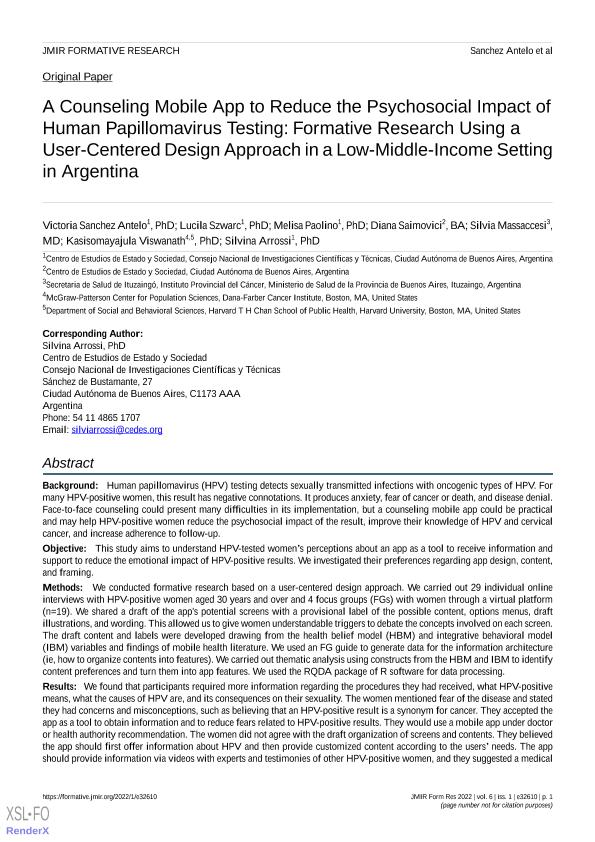Mostrar el registro sencillo del ítem
dc.contributor.author
Sánchez Antelo, Victoria Inés María

dc.contributor.author
Szwarc, Lucila

dc.contributor.author
Paolino, Melisa Delia

dc.contributor.author
Saimovici, Diana
dc.contributor.author
Massaccesi, Silvia
dc.contributor.author
Viswanath, Kasisomayajula

dc.contributor.author
Arrossi, Silvina

dc.date.available
2023-06-13T16:11:15Z
dc.date.issued
2022-01-13
dc.identifier.citation
Sánchez Antelo, Victoria Inés María; Szwarc, Lucila; Paolino, Melisa Delia; Saimovici, Diana; Massaccesi, Silvia; et al.; A Counseling Mobile App to Reduce the Psychosocial Impact of Human Papillomavirus Testing: Formative Research Using a User-Centered Design Approach in a Low-Middle-Income Setting in Argentina; Journal of medical Internet research formative research; JMIR Formative Research; 6; 1; 13-1-2022; 1-18
dc.identifier.issn
2561-326X
dc.identifier.uri
http://hdl.handle.net/11336/200488
dc.description.abstract
Background: Human papillomavirus (HPV) testing detects sexually transmitted infections with oncogenic types of HPV. For many HPV-positive women, this result has negative connotations. It produces anxiety, fear of cancer or death, and disease denial. Face-to-face counseling could present many difficulties in its implementation, but a counseling mobile app could be practical and may help HPV-positive women reduce the psychosocial impact of the result, improve their knowledge of HPV and cervical cancer, and increase adherence to follow-up. Objective: This study aims to understand HPV-tested women’s perceptions about an app as a tool to receive information and support to reduce the emotional impact of HPV-positive results. We investigated their preferences regarding app design, content, and framing. Methods: We conducted formative research based on a user-centered design approach. We carried out 29 individual online interviews with HPV-positive women aged 30 years and over and 4 focus groups (FGs) with women through a virtual platform (n=19). We shared a draft of the app's potential screens with a provisional label of the possible content, options menus, draft illustrations, and wording. This allowed us to give women understandable triggers to debate the concepts involved on each screen. The draft content and labels were developed drawing from the health belief model (HBM) and integrative behavioral model (IBM) variables and findings of mobile health literature. We used an FG guide to generate data for the information architecture (ie, how to organize contents into features). We carried out thematic analysis using constructs from the HBM and IBM to identify content preferences and turn them into app features. We used the RQDA package of R software for data processing. Results: We found that participants required more information regarding the procedures they had received, what HPV-positive means, what the causes of HPV are, and its consequences on their sexuality. The women mentioned fear of the disease and stated they had concerns and misconceptions, such as believing that an HPV-positive result is a synonym for cancer. They accepted the app as a tool to obtain information and to reduce fears related to HPV-positive results. They would use a mobile app under doctor or health authority recommendation. The women did not agree with the draft organization of screens and contents. They believed the app should first offer information about HPV and then provide customized content according to the users’ needs. The app should provide information via videos with experts and testimonies of other HPV-positive women, and they suggested a medical appointment reminder feature. The app should also offer information through illustrations, or infographics, but not pictures or solely text. Conclusions: Providing information that meets women’s needs and counseling could be a method to reduce fears. A mobile app seems to be an acceptable and suitable tool to help HPV-positive women.
dc.format
application/pdf
dc.language.iso
eng
dc.publisher
Journal of medical Internet research formative research
dc.rights
info:eu-repo/semantics/openAccess
dc.rights.uri
https://creativecommons.org/licenses/by-nc-nd/2.5/ar/
dc.subject
ARGENTINA
dc.subject
CERVICAL CANCER
dc.subject
COUNSELING
dc.subject
HEALTH BELIEF MODEL
dc.subject
HPV TEST
dc.subject
INTEGRATED BEHAVIORAL MODEL
dc.subject
MHEALTH
dc.subject
MOBILE APPLICATION
dc.subject
PATIENT EDUCATION
dc.subject.classification
Tópicos Sociales

dc.subject.classification
Sociología

dc.subject.classification
CIENCIAS SOCIALES

dc.title
A Counseling Mobile App to Reduce the Psychosocial Impact of Human Papillomavirus Testing: Formative Research Using a User-Centered Design Approach in a Low-Middle-Income Setting in Argentina
dc.type
info:eu-repo/semantics/article
dc.type
info:ar-repo/semantics/artículo
dc.type
info:eu-repo/semantics/publishedVersion
dc.date.updated
2023-06-12T12:08:52Z
dc.identifier.eissn
2561-326X
dc.journal.volume
6
dc.journal.number
1
dc.journal.pagination
1-18
dc.journal.pais
Canadá

dc.journal.ciudad
Toronto
dc.description.fil
Fil: Sánchez Antelo, Victoria Inés María. Consejo Nacional de Investigaciones Científicas y Técnicas. Centro de Estudios de Estado y Sociedad; Argentina
dc.description.fil
Fil: Szwarc, Lucila. Consejo Nacional de Investigaciones Científicas y Técnicas. Centro de Estudios de Estado y Sociedad; Argentina
dc.description.fil
Fil: Paolino, Melisa Delia. Consejo Nacional de Investigaciones Científicas y Técnicas. Centro de Estudios de Estado y Sociedad; Argentina
dc.description.fil
Fil: Saimovici, Diana. Centro de Estudios de Estado y Sociedad; Argentina
dc.description.fil
Fil: Massaccesi, Silvia. Provincia de Buenos Aires. Ministerio de Salud; Argentina
dc.description.fil
Fil: Viswanath, Kasisomayajula. Dana Farber Cancer Institute; . Harvard University. Harvard School of Public Health; Estados Unidos
dc.description.fil
Fil: Arrossi, Silvina. Consejo Nacional de Investigaciones Científicas y Técnicas. Centro de Estudios de Estado y Sociedad; Argentina
dc.journal.title
JMIR Formative Research
dc.relation.alternativeid
info:eu-repo/semantics/altIdentifier/url/https://formative.jmir.org/2022/1/e32610
dc.relation.alternativeid
info:eu-repo/semantics/altIdentifier/doi/http://dx.doi.org/10.2196/32610
Archivos asociados
